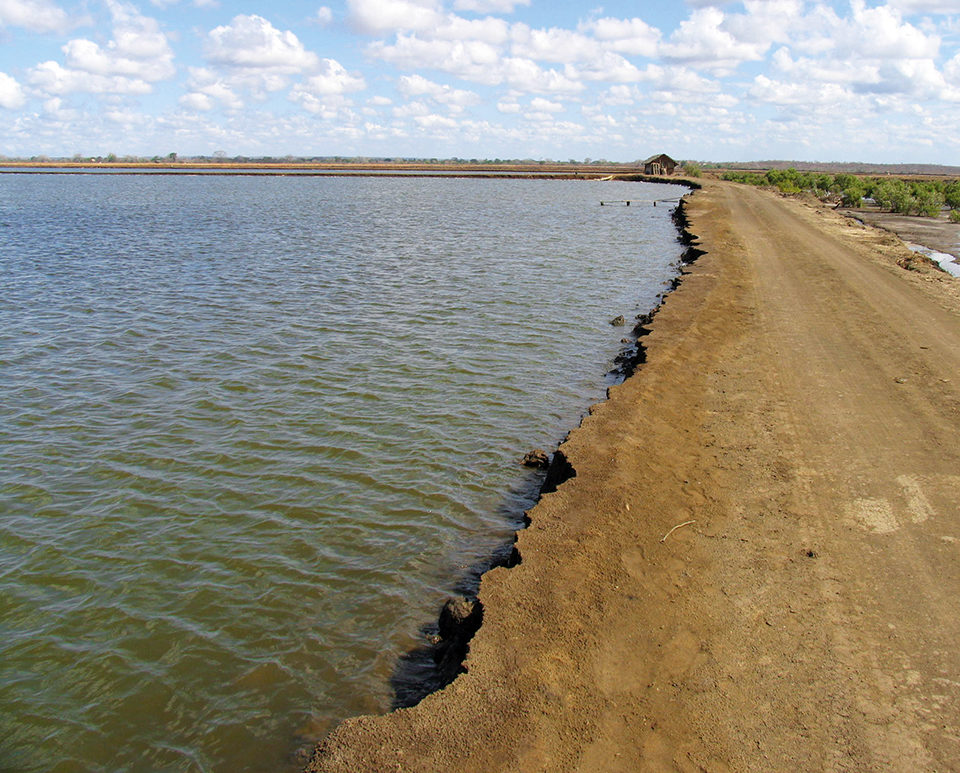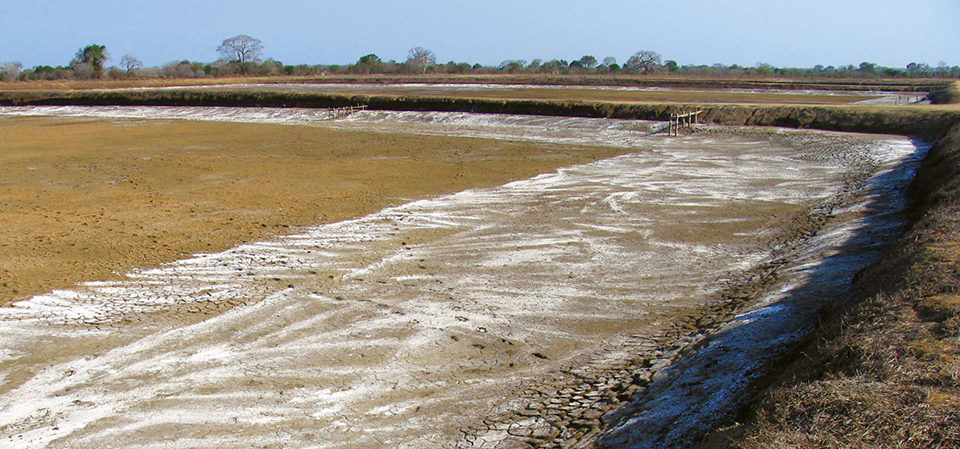Erosion prevention protects farm infrastructure, reduces sediment accumulation

This chapter of “The Shrimp Book” presents a practical discussion of the main issues related to the three main aspects of shrimp pond soil and water management: suitability of site soil and source water, bottom soil condition and water quality during grow-out, and prevention of pollution by farm discharge.
Some areas should be avoided as shrimp farm sites because of general ecological or edaphic features. These include mangrove areas and other sensitive wetlands, sites with organic soils and localities with potential acid-sulfate soils or highly polluted water. Moreover, topography, soil features and source water quality at all prospective sites should be carefully evaluated for the presence of limitations that are not apparent from visual inspection.
If limitations are identified, methods for mitigating them should be assessed for technical and economic feasibility. If mitigation of one or more serious limitations is not possible, a site usually should be abandoned.
Proper construction
Failure to consider soil properties in canal and pond design, and lack of attention to proper techniques in constructing earthwork at shrimp farms are widespread problems. Side slopes of embankments often are too steep and not compacted sufficiently. Side slopes of canals also may be too steep.
Both steep sides and poor compaction favor erosion that degrades earthwork and leads to sediment accumulation in canals and ponds. In addition, there often is no effort to protect erosion-sensitive areas with grass cover, plastic linings or stone, or to minimize erosion by aerator-induced water currents through better aerator placement. The best way of assuring proper construction is to employ a competent engineer and contractor – ones with previous experience in shrimp farm construction.
Prevention of erosion protects farm infrastructure and reduces sediment accumulation in ponds. Nevertheless, farms with highly turbid water supplies should construct an area for treatment of intake water by sedimentation to avoid sediment accumulation in canals and ponds.
Pond bottom management
Pond bottom soil management is rather simple. Ponds should be operated to minimize inputs of suspended soil particles via the water supply and avoid erosion of earthwork. Sediment over 10 cm in depth often interferes with pond management, so pond bottoms should be inspected after each crop and excessive sediment removed. However, it seldom is necessary to remove sediment from entire pond bottoms or after each crop, as is often done in Asia.
Pond bottoms should be dried and tilled with a disk harrow, which pulverizes the soil to allow better contact with the air and promote drying and oxidation. Bottoms of acidic ponds should be treated with agricultural limestone. Remaining wet areas should be treated with lime, and after refilling, ponds should be fertilized to promote natural food before stocking postlarvae.

Liming
Liming deserves special consideration. A shrimp pond bottom can have soil of naturally basic pH that does not need to be limed. Soil pH should be measured in a 1:1 mixture of dry soil and distilled water with the aid of a glass electrode. It is wise to note that soil pH probes that read pH directly in pond bottoms are notoriously inaccurate.
Rates for agricultural limestone applications – note that agricultural limestone, not lime, is recommended for neutralizing bottom soil acidity – are selected according to pH. Recommended applications for agricultural limestone are shown in Table 1.
Boyd, Recommended application rates, Table 1
| Soil pH | Agricultural Limestone Dose (kg/ha) |
|---|---|
| Over 7.5 | 0 |
| 7.0-7.5 | 500 |
| 6.5-6.9 | 1,000 |
| 6.0-6.4 | 1,500 |
| 5.5-5.9 | 2,000 |
| 5.0-5.4 | 2,500 |
| Below 5.0 | 3,000 |
Finely ground agricultural limestone should be spread uniformly over the pond bottom. There is no reason to choose dolomitic limestone over calcitic limestone, provided the two products are of similar neutralizing value and ground to similar fineness. Tilling is useful for mixing agricultural lime throughout the soil mass.
Lime can be applied to areas in pond bottoms that do not dry out between crops as a means of destroying unwanted organisms – including vectors of disease – that survive in wet soil. The treatment rate with lime should be 200 grams per square meter or higher to assure a pH high enough for disinfection. Most shrimp farmers do not apply enough lime to provide a beneficial effect.
Fertilization, pond treatments
During the growout period, ponds should be fertilized with nitrogen and phosphorus until nutrients from feed inputs are adequate to maintain phytoplankton blooms. Mechanical aeration allows shrimp production to be greatly increased and permits water exchange to be lessened or stopped. Aeration usually should be applied at about 1 hp/ha for each 400 kg/ha of anticipated production.
Nevertheless, dissolved oxygen should be monitored to assure that aeration is sufficient to prevent concentrations below 3 mg/L. Many of the products applied to ponds to improve soil and water quality – bacterial cultures, oxidizing agents, enzyme preparations, zeolite and other substances for removing ammonia – are probably ineffective.
In highly intensive shrimp culture, and especially in lined ponds without water exchange, acidity from nitrification in which ammonia from feeding wastes is oxidized to nitrate often causes alkalinity and pH to decline. Alkalinity should remain near 100 mg/L, and liming material should be applied if alkalinity declines.
The amount of liming material needed increases with feed input. The potential lime requirement of feed is 0.4-0.5 kg calcium carbonate/kg feed. Traditional liming materials are not quickly soluble, so some farmers use sodium bicarbonate because it dissolves immediately.
The chapter also discusses compliance with governmental effluent regulations and eco-label certification standards. Best management practices for complying with effluent standards are also presented.
“The Shrimp Book,” published in 2010 by Nottingham University Press (ISBN 978-1-904761-59-4), brings together experts from around the world to fill the critical need for a central reference source on the state of shrimp production practices. With chapters by 67 authors representing the spectrum of shrimp biology and aquaculture – many of whom have contributed to this magazine – the book is addressed to a diverse readership at every step of the shrimp-farming value chain. The editor is well-known shrimp pathologist Victoria Alday-Sanz, DVM, M.S., Ph.D. Overall, the comprehensive book represents an extraordinary effort by many of the most prominent researchers involved in penaeid shrimp studies. With the permission of the publisher, the Global Aquaculture Advocate is presenting a series of summary articles that highlight chapters from “The Shrimp Book.” These summaries are meant to provide a glimpse into the vast knowledge available in the book, and by no means can replace actual reading of this excellent publication.
(Editor’s Note: This article was originally published in the January/February 2012 print edition of the Global Aquaculture Advocate.)
Authors
-

Claude E. Boyd, Ph.D.
Department of Fisheries and Allied Aquacultures
Auburn University
Alabama 36849 USA[117,100,101,46,110,114,117,98,117,97,64,49,101,99,100,121,111,98]
-
Christopher A. Boyd, Ph.D.
Mississippi State University
Coastal Resource and Extension Center
Biloxi, Mississippi, USA -
Suwanit Chainark, Ph.D.
Phuket Rajabhat University
Amphor Muang, Phuket, Thailand
Tagged With
Related Posts

Responsibility
The Shrimp Book: Shrimp pond soil and water quality management
Proper site selection, consideration of soil properties and careful earthwork construction at shrimp farms are essential. Prevention of erosion protects farm infrastructure and reduces sediment accumulation in ponds.

Health & Welfare
The Shrimp Book: Intensive production of shrimp
With relatively low use of land and water, intensive aquaculture systems can support much higher production than extensive systems.

Health & Welfare
The Shrimp Book: Principal shrimp infectious diseases, diagnosis and management
Disease outbreaks in shrimp occur not only due to the presence of pathogens, but also to suboptimal culture conditions and system management.

Health & Welfare
The Shrimp Book: Small-scale shrimp farmers and global markets
It is time to recognize the crucial role of small-scale farmers in Asian aquaculture production and trade. The socially and economically important small-scale sector – the “mainstay” of Asian aquaculture – is innovative, but faced with constraints in modern markets. The sector needs investment from public and private sectors to compete and thrive. Another challenge is to develop certification programs in ways that promote responsible aquaculture expansion with due consideration to small-scale farming.


